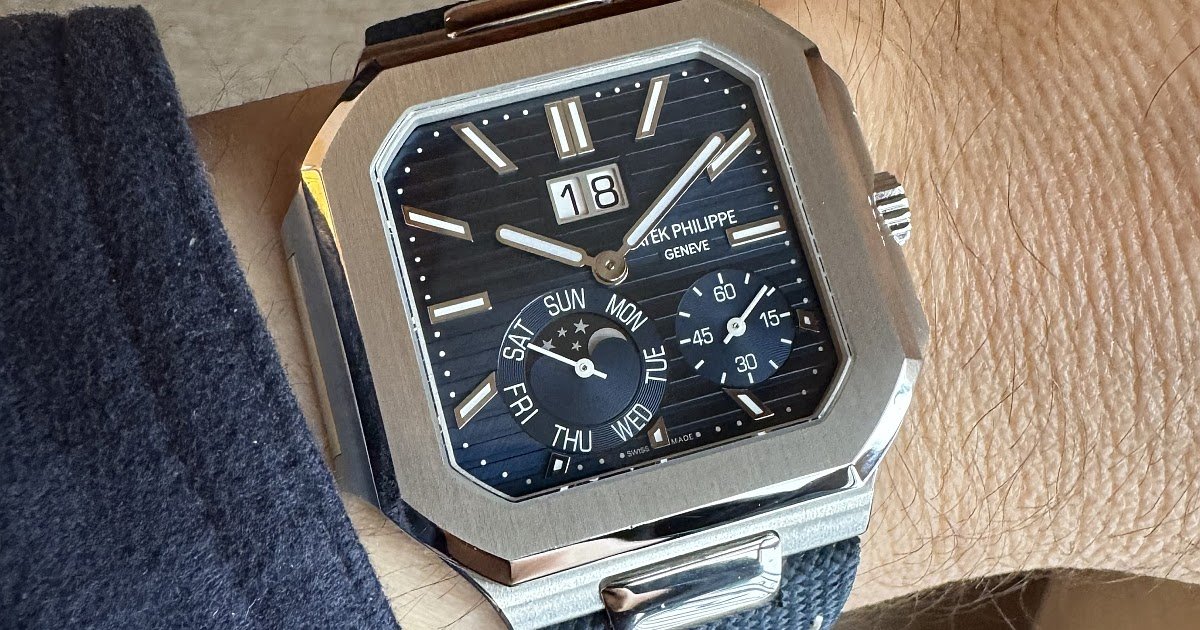Almost everything has been said about the new Cubitus collection from Patek Philippe… or rather about the first 3 watches in the collection. Because by focusing on these 3 watches, we ended up forgetting that Cubitus is a collection and that it is intended to develop subsequently. Some will surely think that it is better that it leaves it there. I tend to think the opposite and that Patek Philippe would rather work on certain areas to take advantage of the potential of the case.
So I saw the three references, the 2 5821 (steel and gold/steel) and the 5822 in platinum. It’s undoubtedly the latter that I liked the most. I see several reasons:
- the fact that the watch is more complicated makes the dial fuller and therefore its perceived size is less than that of the two three-hand watches (I remind you that the diameter from 10 o’clock to 4 o’clock is 45mm),
- the large date works well from an aesthetic point of view with the shape of the case which I would describe as a square octagon (mathematically impossible but you know what I mean),
- The asymmetrical design of the dial breaks the rigidity of the case shape,
- it is equipped with a caliber based on the 240 movement and personally, I have always had a preference for this micro-rotor caliber, which is also beautifully decorated with a presentation of the mass reminiscent of that of the dial,
- and the fact that its bracelet is made of composite material avoids the resemblance with the Nautilus bracelet and thus allows the Cubitus 5822P to have a “more personal” identity.
The caliber 240 which powers the 5822P whose micro-rotor decoration takes up the motif of the dial:
There is also another advantage, but one that is common to all three watches: the slender style of the case. The thickness is 9.6mm for the 5822P, 8.3mm for the 3-hand models and the ratio between the diameter and the height of the case defines fluid proportions which make the watches less massive when worn.
On the other hand, there are elements which convinced me less. This is perhaps a consequence of this desire to want to control the thickness but the water resistance is only 30 meters which is surprising for watches with a sport-chic vocation. This story is a real mystery to me because the same phenomenon took place with the Nautilus which for several months has been advertised with a water resistance of 30 meters. As a customer, I find it difficult to understand why for ages a watch has been advertised at 120 meters and then suddenly the same watch only becomes water resistant to 30 meters. In any case, at least, no more jealous people: Nautilus, Aquanaut, Cubitus, same fight, 30 meters for all… which could suppose that the theoretical waterproofness of the Cubitus would be similar to that of the other two collections.
Reference 5821/1AR:
The other element that didn’t appeal to me was the shape of the movement, round, in a square case. It would have been interesting to work on the shape of the bridges so that the rendering of the two movements, 240 and 26-330, was consistent with the case and specific to the Cubitus collection.
Concerning the two three-hand watches, even if the fluidity of the case is a positive point, the feeling is that the perceived size is slightly too large. This sensation is due not to the diameter but to the surface of the dial. It’s the old principle: for an equivalent diameter, a shaped watch appears larger than a round watch. However, in the end, the 5821 appears generous but is neither disproportionate nor imposing. The wear test confirms that the watch is completely wearable even on an average-sized wrist. The fact remains that aesthetically, it suffers from empty areas on the dial.
The two three-hand models are powered by caliber 26-330:
Ultimately, I would take away the following thoughts from the beginnings of the Cubitus collection. First of all, it’s nice to see shaped watches again, especially from Patek Philippe which had considerably reduced its offering in this area over the years. Then, the Cubitus has potential when it moves away from the Nautilus. The fact that the 5822P does not have the Nautilus bracelet and presents an original dial organization with specific displays (large date and day of the week) makes it much more convincing than the other two models. Otherwise, the comparison with the Nautilus works against the Cubitus. The collection also has the ability to integrate complications and it will be interesting to see how in the future Patek Philippe will work, for example, on the development of the chronograph version. I also think that Patek Philippe will have an interest in offering simple, reduced-size versions, or even offering a two-hand watch with caliber 240, which for me remains an ideal caliber in this context. Thus, the solution would be the presentation of not feminine but mixed watches which, I am sure, would become more attractive than the two 5821s.
Reference 5821/1A:
The Cubitus (I must admit that I have difficulty with this name but we will get used to it over time) has suffered a real firestorm on social networks. This outburst lived up to expectations and the prestige of the factory. But I always thought these reactions were excessive. I think we have to put ourselves again in the situation of starting a collection, that we have to let it develop. The 5822P has reason to believe in its potential and I am convinced that Patek Philippe will be able to define future Cubituses which will receive a better reception. But for this, the manufacture will have to forget the Nautilus to concentrate on the specific identity of the Cubitus.
